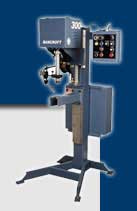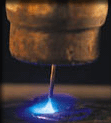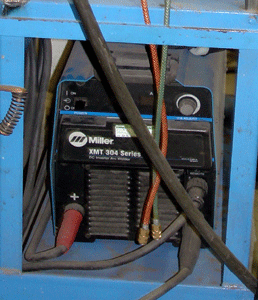Finally I found an application that benefited
from a Lincoln
300 Pulsed Power Source


A condensed review of a weld report
on parts used
in catalytic convertors.
From Ed Craig.
Aug. 2004:
 The
primary issue I found with these automated, Bancroft MIG welded, stainless Torque
Converter parts was the 0.053 thickness and the wide gap. On MIG welded gage parts
that are less than 0.075 “sensitivity to weld burn” through is a concern
when welded with "spray transfer" and these leak tested parts, were
not suited to short circuit. The weld burn through issue is further compounded
when the weld has to be wider to compensate for a lap weld gap which is packed
with stainless mesh. The
primary issue I found with these automated, Bancroft MIG welded, stainless Torque
Converter parts was the 0.053 thickness and the wide gap. On MIG welded gage parts
that are less than 0.075 “sensitivity to weld burn” through is a concern
when welded with "spray transfer" and these leak tested parts, were
not suited to short circuit. The weld burn through issue is further compounded
when the weld has to be wider to compensate for a lap weld gap which is packed
with stainless mesh.
 Using
the recommendations I has previously provided, my
client was using argon - 2% CO2, (Ed developed this gas mix) with 0.035, Using
the recommendations I has previously provided, my
client was using argon - 2% CO2, (Ed developed this gas mix) with 0.035,
(1
mm), 308L wire. For the majority of the stainless tubular applications which were
thicker than 0.070 I had established optimum spray transfer parameters. The spray
mode was proven to be more consistent than the pulsed mode available from the
Miller equipment in the plant. On the parts thicker than 16 gage, the typical
automated weld production efficiency from the Bancroft machines and spray welds,
was approx. 98% and the rework from parts that underwent 100% leak test, was approx.
99%.
For parts thicker than 16 gage,
I established the traditional spray transfer weld data of approx. 180 - 185 amps
and 24 volts with the 0.035 (1mm) wire. However the spray transfer parameters
of 180 amps and 24 volts (minimum) was too hot for the 0.053 lap joints. Using
the same wire and gas, the traditional short circuit mode did not put out sufficient
weld energy for this unique weld joint. Each part underwent an extensive leak
test.
 In
2004 it was not a decision I make often, however I decided that pulsed MIG was
the logical choice for the 304 stainless 0.053
flexible fittings parts.
My other change was the weld wire, the client was using a 309 stainless wire.
I changed them to 308 which is recommended and from a weld perspective the 308
is also less sluggish during the weld solidification. In
2004 it was not a decision I make often, however I decided that pulsed MIG was
the logical choice for the 304 stainless 0.053
flexible fittings parts.
My other change was the weld wire, the client was using a 309 stainless wire.
I changed them to 308 which is recommended and from a weld perspective the 308
is also less sluggish during the weld solidification.
This application
allowed the opportunity to evaluate the capabilitty of the XMT 304 Miller pulsed
power source attached to the Bancroft machines and a new Lincoln Pulsed Power
MIG 300 power source that was made available.
 On
these parts stainless mesh is pressed inside the lap weld joint leaving a wide
gap with mesh across the gap. On an application like this, a wide, soft MIG arc
plasma is important to bridge across the 3/16 wide weld joints on the 0.050 parts.
I found the Lincoln pulsed MIG power source "300" was simple to use.
I set the 0.035 wire feed at 300 ipm and the Lincoln power source provided a wide,
soft plasma configuration that was suited for this application. On
these parts stainless mesh is pressed inside the lap weld joint leaving a wide
gap with mesh across the gap. On an application like this, a wide, soft MIG arc
plasma is important to bridge across the 3/16 wide weld joints on the 0.050 parts.
I found the Lincoln pulsed MIG power source "300" was simple to use.
I set the 0.035 wire feed at 300 ipm and the Lincoln power source provided a wide,
soft plasma configuration that was suited for this application.
Using the Lincoln power source and the 0.035, 308L, wire with argon 2% CO2
gas, optimum and consistent MIG welds were produced with the tubular weld joints
rotated allowing the weld position to be "vertical down". The vert down
position will always greatly
reduce the weld burn through potential on
any gage applications < 16 gage.
Lincoln MIG 300 Power Source Procedure: (Note this is 2004)
[] Set the pulsed stainless program #32.
[] 0.035
Wire feed set at 300 ipm.
[] Pulsed Average Amps delivered "113 amps".
[] Volts 20.
[] Part Rotation, weld speed 40 ipm.
MILLER FAILED:
I tried to duplicate the low amp pulsed weld characteristics with the Miller XMT
304 equipment attached to the Bancroft machines. With the Miller equipment and
a wire feed rate of 300 ipm, the built in pulsed weld schedule provided
higher weld current with a narrower digging plasma. I also used the Miller
pulsed program that allows
pulsed parameter adjustments however none of the
adjustments could duplicate the plasma and low parameters attained by the Lincoln
equipment.
(Note I believe Lincoln's expertise with the
STT was evident in the pulsed program in the 300).
The Miller pulsed
MIG weld results were a disappointment. Achieving a consistent pulsed MIG weld
under 120 amps, a weld with a suitable wide and soft plasma configuration was
not going to happen with the Miller XMT 304 equipment.
Conclusion:
[a] If your company is designing stainless tubular parts less than 1.6 mm
make sure the designers who typically don't have a clue about welding, are aware
of the potential MIG weld quality / productivity issues that will occur from their
thin gage designs. God help them if they ever read a book on this dam subject.
[b] Be aware that the pulsed mode is recommended for this applications however
as each pulsed power source provides different pulsed out put weld characteristics,
the pulsed power source in your plant may not provide the optimum pulsed arc characteristics
necessary for your gage stainless application. So determine your needs carefully
before selecting that pulsed MIG equipment.
[c]
If this application had been steel, the pulsed mode would not have been necessary,
as there would have been sufficient weld energy from the traditional short circuit
transfer mode.
[d]
On applications sensitive to weld burn through, the weld position presented can
dramatically reduce the weld burn through potential and provide consistent weld
quality.
[e] This company initially use 309 MIG wire for the 304 applications.
The 308 is recommended and its beneficial as it's less sluggish providing better
weld wetting and fusion.
 A
discussion was had on the necessary equipment required for this low to moderate
volume application. Bancroft machines are great, however they are also can be
costly. A
discussion was had on the necessary equipment required for this low to moderate
volume application. Bancroft machines are great, however they are also can be
costly.
For
this application that did not require a daily high production rate, the parts
could have been successfully welded with automation using a basic, small rotary
lathe type positioner which would cost approx. $2000 - $3000. With the Lincoln
power source which cost approx. $4000, a fixed torch, cost $600 mounted on a bracket,
a gun on-off switch and an arc on, arc off timer. The bottom line. For approx.
$8000 this application could have been automatically welded with the same quality
and productivity success as achieved from automated equipment that can cost five
to ten times more.
2004:
It's not often I thank Lincoln, but this time I thank them for producing a reasonable
priced pulsed weld power source that actually provided a real world weld benefit.
Stainless has always been an alloy that can benefit from the pulsed mode when
short circuit or spray is not suited. It was also unusual to see a Lincoln pulsed
power source perform in a consistent manner..
| |